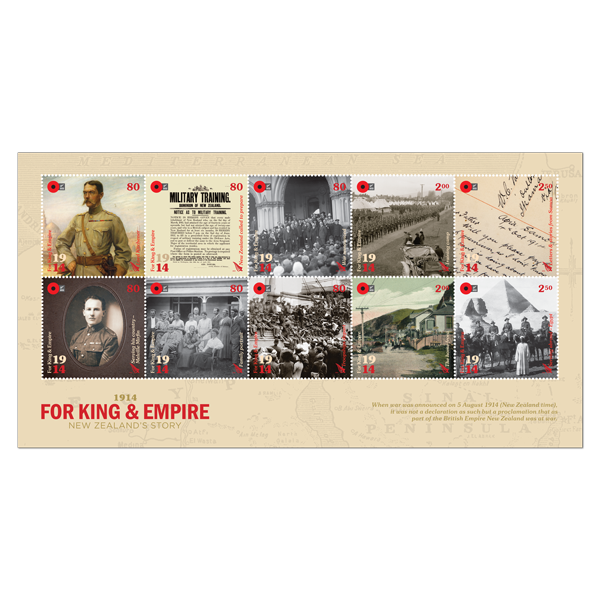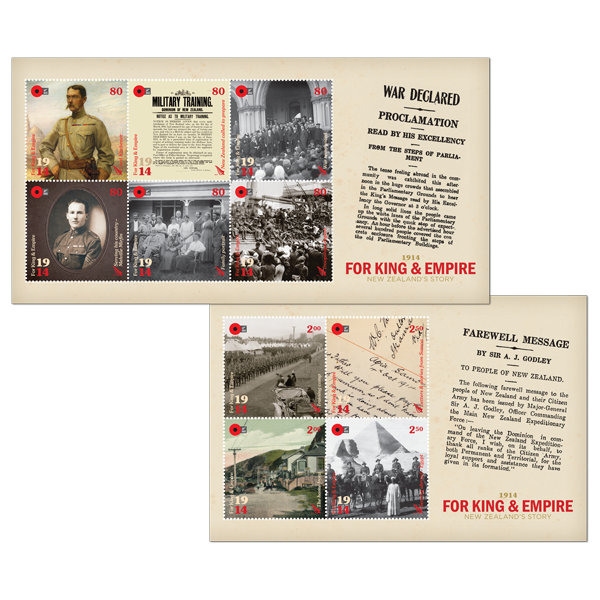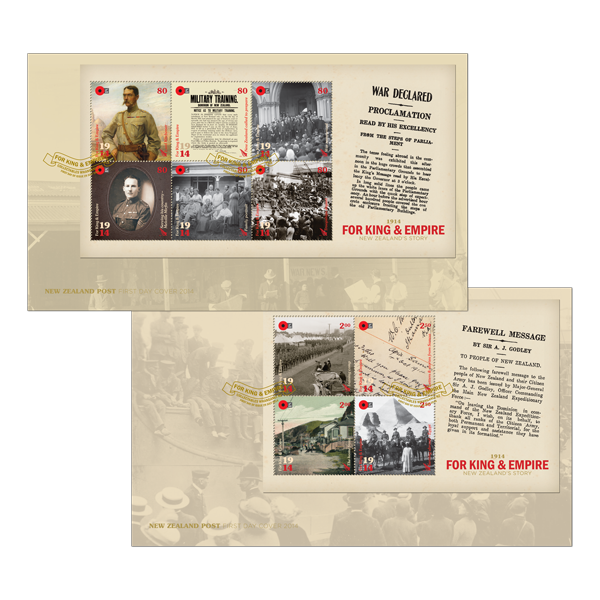The declaration of war affected nearly every New Zealander; with a population of just one million and approximately 100,000 people being sent overseas to war, around 18,500 New Zealanders would not make it home.
Issue information
At 3pm on 5 August 1914, an audience of around 15,000 huddled together in front of the steps of parliament. The crowd excitedly cheered as the Governor, Lord Liverpool stepped forward from a group of his peers. As he made the announcement, you could feel the crowd’s sparks of excitement grow into a roaring flame. Wellington was abuzz with the news that had spread throughout the city – New Zealand was going to war.
In the coming years of this five-year commemorative programme, we look at the war from a New Zealand perspective. From the front line to the home front, New Zealand was changed forever while this experience began to forge our identity as a confident, stand-alone country.
In 2014, we looked at the untold story of New Zealand serviceman and everyman, Melville Mirfin. Like thousands of others, Mirfin left his family behind and answered the call to go to war, but unlike so many soldiers, he not only survived the war, but he survived the action from one end of the war to the other.
The first stamps in this special five-year commemorative programme were complemented by the sheetlet, two miniature sheets, first day cover and two miniature sheet first day covers.
Commemorative Booklet
This commemorative book, designed to look like a pocket book like soliders carried in the war, was written by Mark Di Somma with assistance from the Mirfin family (including Melville’s son John Mirfin). This commemorative book was the first in our five year series, and when you purchased the book, you received a commemorative case to contain the full series.
The Melville Mirfin Story
While it is impossible to tell every individual story of WWI, as part of each stamp issue over the five year WW1 programme, we told the wider story of the war through the eyes of an everyday New Zealander.
In 2014 we told the story of Melville Mirfin. Like thousands of others, Melville Mirfin left his family behind and answered the call to defend King and Empire. But unlike so many of them, he not only survived the War, he survived action from one end of the war to the other, taking him from his humble home town of Ikamatua to Samoa, Egypt, Turkey, the Western Front and finally to London.
Born at Ikamatua on the West Coast of the South Island, Melville Mirfin spent 4 years and 359 days overseas. His postings ranged from Samoa in 1914 to Egypt in 1915, the Balkans in 1915, Egypt in 1916, the Western Front from 1916 to 1918 and finally the occupation of Germany in 1919. Outside of the officer corps, he must have been one of the longest serving New Zealand soldiers during World War 1.
A suitcase belonging to Melville, containing letters, postcards and photos of his time overseas had been passed down and cared for by the Mirfin family for 100 years. When Melville returned to New Zealand many people gave him back the letters he had written them and these were also stored in the suitcase - giving a very clear and detailed account of what he experienced between 1914 and 1919.
Throughout the five-year programme the stamps showed a range of media to portray New Zealand’s involvement in the war. Posters, postcards, letters, diaries and photos that were brought home will show the mundane and the unimaginable to an extent never seen before. Though the servicemen may no longer be with us, those records live on, and it is our intent to remember, honour and commemorate those who bravely served 100 years ago.
Product Listing for 1914 For King and Empire
| Image | Title | Description | Price |
|---|---|---|---|
 |
Sheetlet |
Mint, used or cancelled sheetlet of ten stamps. The individual stamps in this issue were: Single 80c 'Lord Kitchener' gummed stamp. Lord Kitchener (Kitchener of Khartoum) is the embodiment of the Empire and its influence in New Zealand in the years leading into World War One. He recommended the withdrawal of New Zealand troops from Gallipoli in 1915, before perishing onboard the HMS Hampshire in 1916. Single 80c 'New Zealand called to prepare' gummed stamp. The Defence Act of 1909 was the first step towards compulsory military training, enacted in 1911 (on advice from Lord Kitchener). By 1911, posters such as this one could be seen throughout New Zealand. Single 80c 'War announced' gummed stamp. When war was announced on the 5th of August 1914 (New Zealand time) it was not a declaration as such, but a proclamation that, as part of the British Empire, New Zealand was at war. Single 80c 'Serving his country – Melville Mirfin' gummed stamp. Melville Mirfin was a bank clerk from a family of seven from Ikamatua on the West Coast of the South Island, who, alongside many others, signed up for war the same week of the proclamation on August 5th. Single 80c 'Family portrait' gummed stamp. War inevitably split families across continents and the Mirfin Family is pictured here prior to war, showing all the brothers who would serve and survive. Single 80c 'Troopships depart' gummed stamp. The Limerick, also known as HMNZT 7, was one of ten troopships in the ‘First Fleet’ that took the NZEF, their horses, and equipment to Egypt in 1914, meeting up with the Australian Imperial Force enroute. Single $2.00 'Training camp' gummed stamp. Training camps such as this one in Canterbury readied troops for the NZEF, destined for Europe (they would instead go to Egypt) before the year’s end. Single $2.00 'The home front' gummed stamp. Karaka Bay, Wellington, in 1914 – Semi-rural, with some modernity, less than half New Zealand’s population prior to World War One was considered urban, a number that would increase to sixty per cent by the war’s end. Single $2.50 'Letters and stories from Samoa' gummed stamp. New Zealand’s first duty in World War One was capturing Samoa from the Germans. Melville Mirfin, who had signed up for the NZEF in the first days of August, travelled to Samoa with 1,385 men, during which he would write many times to his family. Single $2.50 'Serving abroad – Egypt' gummed stamp. By the end of 1914 the first troops of the New Zealand Expeditionary Force had arrived in Egypt for training. For many it was their first time away from New Zealand shores, and they found themselves in front of the Pyramids of Egypt, ready for what was supposed to be the great adventure. |
$13.80 |
 |
Set of Miniature Sheets | Mint, used or cancelled gummed set of two miniature sheets. | $13.80 |
 |
Sheetlet First Day Cover | First day cover with stamp sheetlet affixed. | $14.30 |
 |
Set of Miniature Sheet First Day Covers | Set of two first day covers with miniature sheets affixed. | $14.80 |
 |
Miniature Sheet Booklet |
The Melville Mirfin story is honoured in this special commemorative book, featuring never-before-seen imagery of the Great War through Mirfin’s eyes. This collectable, contained unique miniature sheets, sheds light on why we would answer the call to war for Great Britain and how through this tragic event, New Zealand began forming her own identity. This commemorative book was the first in our five year series, and if purchased you received a commemorative case to contain the full series. |
$39.90 |
Technical information
| Date of issue: | 29 July 2014 |
|---|---|
| Number of stamps: | Ten gummed stamps |
| Stamps and first day covers designed by: | Strategy Design and Advertising, Wellington, New Zealand |
| Denominations: | 6 x 80c, 2 x $2.00, 2 x $2.50 |
| Printer and process: | Southern Colour Print Ltd by offset lithography |
| Number of colours: | Four process colours |
| Stamp size and format: | 36.95mm x 37.5mm (horizontal) |
| Paper type: | Tullis Russell 104gsm red phosphor gummed stamp paper |
| Number of stamps per sheet: | 24 |
| Perforation gauge: | 14.4 x 14.62 |
| Special blocks: | Plate/imprint blocks could be obtained by purchasing at least six stamps from a sheet. Barcode blocks were available in A and B formats. |
| Period of sale: | These stamps remained on sale until 28 July 2015. |




